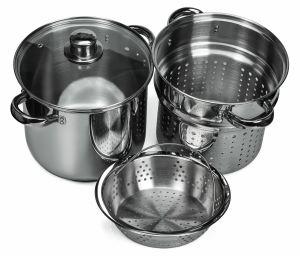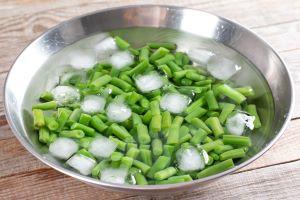Blanching is the process of scalding vegetables in boiling water or steam for a short amount of time. Blanching is a must for most vegetables that are frozen. The blanching process is important to slow or stop enzyme action that causes loss of flavor, color, and texture. Blanching time is important and varies with the vegetable and size of the pieces. Under-blanching stimulates the activity of enzymes and is worse than not blanching. Over blanched vegetables cause the loss of flavor, color, vitamins, and minerals.

Blanching Directions
1) Wash, drain, sort, trim and cut vegetables.
2) Use 1 gallon water per pound of prepared vegetables or 2 gallons water per pound of leafy greens.
3) Put vegetables into blancher (wire basket, coarse mesh bag or perforated metal strainer) and lower into boiling water. Or steam blanch: Add 1-2 inches of water to a pot and bring to boil then put a single layer of vegetables in the basket.
4) Cover. Start counting blanching time as soon as water returns to a boil. If using steam blanching, the count starts immediately.
5) Keep heat high for the time given in the directions.
6) Cool immediately in ice water or cold water (60 degrees F or below) for the same time used in blanching (except for corn on the cob for which cooling time is twice the time of blanching). Stir vegetables several times during cooling.
7) Drain vegetables thoroughly. Use a salad spinner for firm vegetables.
8) Pack the vegetables either by dry-pack or tray-pack.
Dry-pack: Pack vegetables tightly into containers or freezer bags. Press out air and seal tightly.
Tray-pack: Put a single layer of the vegetables on a shallow pan and put the pan into the freezer. As soon as the vegetables are frozen, put them into a freezer bag or container. Press out air and seal tightly.
9) Freeze. Frozen vegetables will maintain high quality for 8 to 12 months at zero degrees F or lower.

Freeze food at zero degrees Fahrenheit or lower. Do not overload the freezer when freezing vegetables. It will take longer to freeze. Frozen vegetables will maintain high quality for 8 to 12 months at zero degrees F or lower.
Using proper packaging material for freezing food is important to help protect flavor, color, moisture content and nutritive value of the food while in the freezer.
In general, rigid containers, such as glass and plastic, are suitable for all packs, especially for liquid packs. Regular glass breaks easily at freezer temperatures. If using glass jars, choose wide mouth jars that are made for freezing and canning. Plastic freezer-grade bags are good for dry packs with little to no liquid. If using plastic bags, press them to remove as much air as possible before closing.
General characteristics of packaging materials should be:
• Moisture vapor resistant
• Durable and leak proof
• Made of freezer grade material
• Resistant to oil, grease or water
• Protect foods from absorption of off flavor or odors
• Easy to seal - use freezer tape if needed to reinforce the seal
• Easy to label and date
• Containers that hold less than a one-half gallon

Headspace is the unfilled space above the food in a container and below the top of lid that allows the food to expand during freezing.
Asparagus
Wash. Sort according to thickness. Discard the tough part of stalk. Cut into even lengths to fit container. Blanch, cool, and drain package, leaving no head space. Label, date, and freeze.
Blanching Time (minutes): Small – 2, Medium – 3, Large – 4
Beans (snap, green or wax)
Wash. Remove ends. Snap or cut into 2–4-inch lengths. Blanch, cool, drain and package, leaving 1/2-inch head space. Label, date, and freeze.
Blanching Time (minutes): 3
Beets
Wash and sort according to size. Trim tops, leaving 1/2-inch stem and root. Cook in boiling water until tender: for small beets 25-30 minutes; for medium beets 45-50 minutes. Cool in cold water, peel, remove stem and root and cut into slices or cubes. Package leaving 1/2-inch head space. Label, date, and freeze.
Blanching Time: Cook until tender
Broccoli
Remove leaves and woody portions. Wash. If desired, soak 30 minutes in brine (4 tsp. salt to 1 gallon water) to remove insects. Trim flowerets to 1 to 1 1/2 inch across. Blanch, cool, drain and package, leaving no head space. Label, date, and freeze.
Blanching Time (minutes): 3, or steam blanch 5
Brussels Sprouts
Select green, firm, and compact heads. Trim, wash, and sort according to size. Blanch, cool, drain and package leaving no head space. Label, date, and freeze.
Blanching Time (minutes): Small – 3, Medium – 4, Large – 5
Carrots
Remove tops, wash, and peel. Cut as desired. Leave small carrots whole. Blanch, cool, drain and package leaving 1/2-inch head space. Label, date, and freeze.
Blanching Time (minutes): Whole – 5, Cut – 2
Cauliflower
Wash. If desired, soak 30 minutes in brine (4 tsp. salt to 1 gallon water) to remove insects. Trim the head into 1-inch pieces across. Blanch in water containing 4 teaspoons salt per gallon of water. Cool, drain and package, leaving no head space. Label, date, and freeze.
Blanching Time (minutes): 3
Corn
Select tender, freshly gathered corn. Husk, trim, remove silk and wash. Blanch, cool quickly and completely, drain and package, leaving no head space.
On the Cob - Husk, trim, remove silk and wash. Blanch, cool quickly and completely, drain and package, leaving no head space.
Blanching Time (minutes): Small – 7, Medium – 9, Large - 11
Whole Kernel - Blanch corn on cob. Cool, drain and cut to about 2/3’s the depth of the kernel. Package, leaving 1/2-inch head space.
Blanching Time (minutes): 4
Cream Style - Blanch corn on the cob. Cool and drain. Cut kernel tips from cob and scrape the cobs with back of knife to remove juice and heart of kernel. Package, leaving 1/2-inch head space.
Blanching Time (minutes): 4
Greens (including Swiss chard, spinach & collards)
Preparation: Select young tender leaves. Wash thoroughly. Remove woody stems. Blanch, chill, drain and package, leaving 1/2-inch head space. Label, date, and freeze.
Blanching Time (minutes): 2; Collards – 3
Herbs
Wash, drain, pat dry. Wrap in freezer wrap and place in freezer bag. Freeze. Use in cooked dishes. Label, date, and freeze.
Blanching Time (minutes): N/A
Peas, shelling
Preparation: Use young, tender peas. Shell, blanch, cool and drain. Package leaving 1/2-inch head space. Label, date, and freeze.
Blanching Time (minutes): 1 1/2 to 2 1/2
Peas, edible pod
Select flat, tender pods. Wash. Remove stems, blossom ends and strings. Leave whole. Blanch, cool, drain and package, leaving 1/2-inch head space. Label, date, and freeze.
Blanching Time (minutes): Small – 2, Large – 3
Peppers (bell or sweet)
Wash, stem, and seed. If desired, cut into 1/2-inch strips or rings.
Heated - Blanch, cool, drain and package leaving 1/2-inch head space. Use in cooking.
Raw - Spread loosely on a tray. Freeze, then pack, leaving no head space. Use in uncooked or cooked foods. Label, date, and freeze.
Blanching Time (minutes): Halves – 3, Strips – 2
Pumpkin or Winter Squash
Wash. Cut into pieces and remove seeds. Cook until soft . Scoop out pulp with a spoon to separate from skin and mash. Cool quickly by placing pan in cold water. Package leaving 1/2-inch head space. Label, date, and freeze.
Blanching Time: Cook
Summer Squash (including zucchini)
Sliced - Wash and cut into 1/2-inch slices. Blanch, cool, drain and package, leaving 1/2-inch head space. Label, date, and freeze.
Blanching Time: 3
Grated - Wash and grate young tender zucchini. Steam blanch small amounts. Package, leaving 1/2-inch head space. Cool by placing containers in cold water. Pack in measuring amounts. Best used for baking. Label, date, and freeze.
Blanching Time (minutes): Steam 1 to 2
Tomatoes
Wash and dip in boiling water for 30 seconds to loosen skin. Peel and core. Freeze whole or in pieces. Package, leaving 1 inch head space. Use for cooking. Label, date and freeze.
Blanching Time (minutes): N/A
Created: 2006; Updated: November 2023
Adapted from: E. Andress, J. Harrison. So Easy to Preserve, Sixth Edition. Cooperative Extension. The University of Georgia, Bulletin 989, ©2014.
* Adapted from: University of Minnesota Extension. https://extension.umh.edu. Accessed 04/11/19
Updated by Ann Hamilton, Food Safety Field Specialist, UNH Cooperative Extension.
For More Information
For more information of food preservation, go to the National Center for Home Food Preservation Website - https://nchfp.uga.edu/.
State Office
Taylor Hall
59 College Rd.
Durham, NH 03824
http://extension.unh.edu
Education Center and Information Line
answers@unh.edu
1-877-EXT-GROW
(1-877-398-4769)
9 am–2 pm M–F
